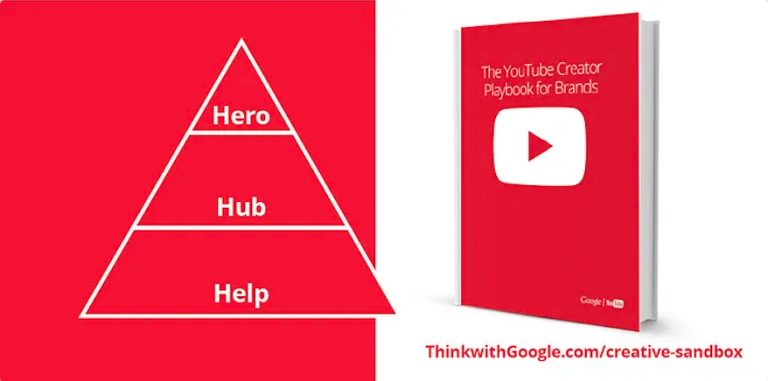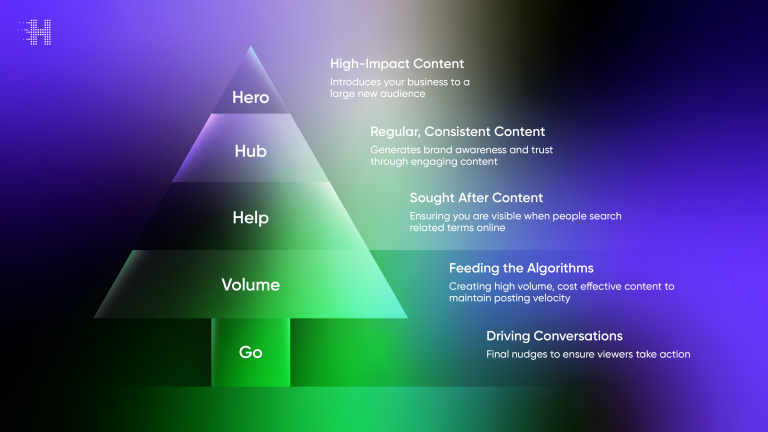Is the 8-year-old Hero, Hub & Help content fit for purpose?
I’ve been talking about the Hero, Hub, Help model (HHH) for years, I first talked about it in my first book in 2018, and by my second book in 2021, the model had become widely recognised across marketing. To this day, it’s the one model that a client is likely to mention in a content planning session.. but is it actually useful?
In this article, I’ll be looking at why the model was designed in the first place, how it’s being used and the value it has for brands. Finally, I’ll be looking at ways to make the model more relevant for modern brand content planning… which (spoiler alert) kind of gives away what I feel about the model already.
Why do we need models for content planning?
I’m all for planning models. They create simplicity of thought in the planning process and give a visual way of structuring thinking. A good model is something that everyone in a company can understand and get behind … not just the planning team. Yes, models may oversimplify things in the eyes of some experts, but they form a simple drumbeat that people can step in time to. In the end, it is this alignment that creates movement, and this movement is more important than the perfection of planning. The HHH model falls firmly into this playing field, taking the hugely complex area of brand content, storytelling and formats and boiling it down to a simple pyramid.
The model was initially developed to help YouTube creators plan their content. In 2015 a team from YouTube sat down with a team at London-based We Are Social to discuss how creators could approach planning content. The teams eventually divided films into Hero videos, Hub videos and Help videos. This became an article about scheduling video content and a Think with Google YouTube playbook.
The model was promoted by YouTube as the go-to approach for businesses and individuals wanting to succeed on the video-sharing platform. It become the de facto approach to structuring content for many brands. The framework is often represented as a pyramid with a large quantity of “help” content as a foundation and “Hero” content (which is produced the least) at the top. For those of you who need a refresher on the content types, I’ve written a couple of sentences on each below and you can look further down this article for examples and more details.
Hero content is typically the most entertaining and it goes a bit on emotional connections. The key attribute of hero content is that it appeals to a wide section of potential consumers, this is not the time for microniching audiences! According to Google, hero content is “big, tent-pole events that are designed to provide a massive step-change to your audience growth.”
Hub content is a regular output to encourage engagement and retention, typically working as a series or resource hub so people are likely to return. Hub content is normally pushed to subscribers via notifications or email rather than paid activity. It appears on a regular schedule and when done right, becomes part of your audience’s routine.
Help content, which Google has also (confusingly) called “hygiene content,” is in some ways the purest form of content marketing. It answers specific questions and creates interest via organic search. Help content is typically lower budget but high volume.

YouTube’s HHH model
Limitations of the Hero Hub Help model
Everything we have talked about so far is well-trodden ground, but the model, which has been around since 2015, is looking tired and (in my humble opinion) fails to encapsulate enough detail to be helpful for most brands. Yes, it’s better than nothing, but it could be so much better! here are my top issues with it…
- The HHH model is only YouTube-focused. It’s great for Youtubers and content creators (as it was literally invented for them), but it’s not enough for a brand to hang its hat on. It is missing key parts of the role of content.
- Because YT doesn’t want to send ad revenue-generating viewers elsewhere, the model ignores a large part of the business .. the bottom-of-funnel business of selling. This can lead brands to not think about conversion content for the bottom of the sales funnel, for example, “buy now” or “discount” messaging.
- Some content simply doesn’t fit the HHH model – when it was written no one was thinking about TikTok viral trends, silly dances and other mass volume outputs. These are now core outputs for all brands that take their content seriously.
How the HHH model can be adapted for brands in the 2020s
OK, now it’s time to go out a limb. After 30 years of making videos and a decade of focusing on video marketing, I feel confident enough to propose two simple tweaks to make the model more flexible and more effective. We simply add “Volume” and “Go” content types and add these at the bottom of the diagram.
Before I go into why we should include these, I should add that any ideas you have for the titles of these video types would be greatly appreciated.. “volume’ isn’t quite landing with me yet!
Volume content type
If the brand teams are holding the torch for Hero films, the content team’s best friend is ‘volume’. These films are regular, low-cost, snackable, and super on-trend. These are the films that feed the beast that is the social media algorithm. Volume content should be well planned, but executed with low effort, in high volume, and at speed. How you approach videos in this category is something for another blog, but this is where you add character to the brand, showing your funny or flip side. A perfect example is almost all organic brand TikToks. We worked with World of Books to set up a TT channel that did exactly this and it added colour and depth to the conversation they were having, as well as demonstrating a willingness to take part in the book community.
GO! Content type
At the very bottom of the model is GO! content. This is the final step in the process to get conversions. This content type is where you run discount codes, introduce FOMO with limited offers and every other trick in the book to drive sales. I’ve ummed and eerd about adding the exclamation mark to the GO! … but this content deserves it. After all, this is what’s going to drive those conversions.
Shelter Christmas Campaign 2022
In the chart below you can see that I’ve made the graphical representation of the formats more of a tree than a pyramid. This is simply done by the quantity of films that you should produce. Brands don’t need many hero films, they need more hub films and even more help films. It’s obvious from the name alone that you need lots of ‘volume’ films, and finally, you simply don’t need many ‘go” films as they are highly tactical and focused.

Jon Mowat has updated the Hero Hub Help model
-
Here’s a full explanation of each type of content in the HHH model (as promised earlier)
Hero films
Hero content refers to the big, tent-pole events that provide a massive step change to your audience growth. A live-streamed event, a viral video… a cross-promotion with a YouTube influencer, or even a made-for-YouTube ad. It may revolve around a large cultural event… or it may be a major event that you instigate.
As Hero content is the form most likely to be pushed into people’s lives, if it fails to deliver on an emotional level or is perceived to be of low value it is likely to fail overall. As an example of how much people get upset with things they don’t want being pushed onto them, just search online for ‘unwanted U2 album’. It will reveal how the supposedly mutually beneficial relationship between U2 and iTunes became a public relations nightmare, turning the social media airwaves blue with vitriolic frustration.
Let’s look at some Hero films. If you’ve previously read around this topic you will no doubt be slightly bored by the web’s insistence on talking about Evian babies and Jean-Claude Van Damme’s backwards Volvo trucks, both of which are just old-school TV spots put online. Let’s instead cover some exciting examples starting with emotional Hero films, which in my opinion are always the best to watch.
Let’s start with a straightforward enough style of Hero film. This 30-second ad, created by Hurricane for Sykes Holiday Cottages in the UK, is interesting as it builds itself around the emotional idea of spending your holiday time carefully. The campaign centred around a 30-second short aimed at a wide audience with core messaging, which was then spun into numerous digital versions, each used as stand-alone Hero films at specific parts of the market. Consider how the film focuses on the emotions of people in the film, rather than a list of features and benefits.
Every Day is a Story for Huawei
Better Learning for Cambridge University Press
Hub films
Hub films are where we deepen conversations. They tend to be longer and people come back and watch more. If we take a Red Bull example again they actually did a big series called “Who is Job” following a pro surfer in their life just mooching about being a surfer dude.
Real-life Baristas for Costa Coffee
Help films
help films are the most underrated kind of films as they make you an indispensable resource and can deliver great results. They lean into organic search and are vital for SEO performance, both on your site and social.
We worked with Calor Gas on a film about setting up a barbeque, which now has 250,000 views organically.
About the author
Jon Mowat is MD at Hurricane Media and has been a leading expert on video and content marketing for over 20 years. He started his career as a documentary maker at the BBC, where he travelled the world covering wildlife, current affairs and features. Jon is the author of two books on video marketing, which have now been translated into 6 languages. As well as leading the strategy department of Hurricane he works as a marketing consultant for UK and Global brands.